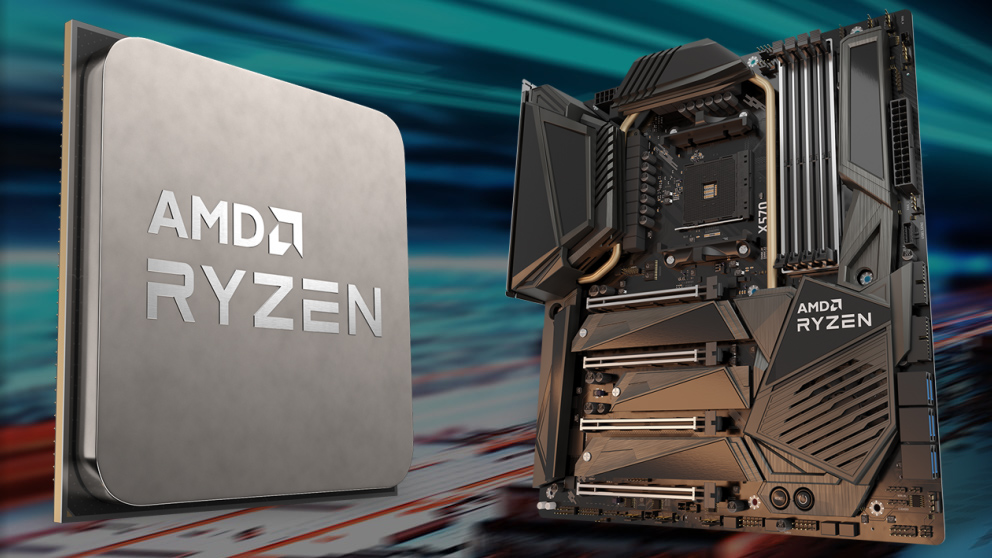
AMD continues to take a blow torch to its rivalry with Intel with the announcement of its Zen3 Ryzen 5000 processors, along with newly unveiled laptops.

AMD's new Zen3 based Ryzen 5000 processors. Image: AMD composite.
AMD has at long last unveiled the Zen3 client processor lineup, along with the official naming as the 5000 series. This is to alleviate confusion, as the Zen2 based mobile processors already on the market have the Ryzen 4000 naming scheme. Additionally, in China the number 4 carries some negative connotations, and since the Chinese market has become an area of significant growth for AMD it's seeking to avoid the potential negative marketing.
Will the AMD Zen3 live up to its high expectations?
AMD is using a new fabrication process at TSMC, but being still a 7nm process, it is by itself not a big advantage over Zen2. It does however allow AMD to increase its transistor density and power efficiency. The question then is, what has AMD done with that extra transistor budget?
The first indication of what to expect is that AMD hasn't significantly changed the power envelopes for its various models. The second is that AMD is increasing the prices a little bit.
Zen3 is still based on a chiplet design, using the same I/O chiplets as Zen2. AMD has also combined what used to be two 4 core chiplets into a single unit with a unified shared third level cache. This shared cache allows all of the cores to have access to more cache with lower latency. AMD has also redesigned the processor pipeline.
Intel has retained dominance in gaming largely by dint of a large edge in boost clock speeds that are still a primary factor in gaming performance. Its newer 10nm SuperFIN process shows promise for a large improvement in power efficiency that ostensibly give Intel a leg up. In Zen2 AMD brought its IPC (Instructions per Clock) to near parity with Intel's. In other words, a 4GHz Zen2 based Ryzen 9 pretty nearly matched a 4GHz i9, but Intel has been able to raise its boost clock to over 5GHz.
AMD hasn't achieved quite that high a clock speed, with its new Ryzen 9 boost clock peaking at 4.9 GHz, but by raising its IPC by 19% Zen3's single-threaded performance now exceeds that of Intel's gaming flagship, rendering its clock speed advantage moot, in fact giving AMD a lead in single-thread performance and for the first time in 14 years giving AMD a lead in gaming performance over Intel.
The increased cache size per core and higher cache performance will also offer some benefits for multi-core performance, making AMD's edge in content creation applications bigger. AMD's estimated 50% improvement in floating point performance will further cement that lead.
HP Zen3 laptops
HP recently unveiled several Zen based laptops across its entire spectrum from entry level to workstation, and there will almost certainly be more such announcements from the gaming and workstation laptop manufacturers soon. AMD already had quite a few design wins to showcase at the last CES conference, so it shouldn't be long until Zen3 mobile systems start becoming available for purchase and Intel loses the gaming performance crown altogether.
The desktop Ryzen 5000 series processors are scheduled to be available on November 5, while the mobile version release dates are still unknown. The release dates for the mobile versions are as yet unknown, so in the meantime Intel will almost certainly try to sell as many i9s as it can.
14 years ago when AMD last had an edge in performance, it was able to force Intel to implement its x86-64 ISA, but it still had nearly no impact on market share. Demand was on AMD's side, but capacity was not; AMD was back then relying on its own fab, and while it was extremely advanced, compred to Intel's fabrication capacity it was quite small. AMD simply couldn't make enough processors to make a dent in Intel's sales.
When Apple moved its processor production from TSMC's 7nm process to its 5nm process, AMD bought up a good chunk of the newly available capacity in order to ensure that it would be able to keep up with the growing demand for its products. It's also in talks to acquire Xilinx, and industry leader in the FPGA market, which would enable AMD to gain a foothold in some new industries in addition to giving AMD a leg up in expanding its datacenter offerings.
AMD will rule the desktop this winter, and when the Zen3 server and workstation models start shipping, it will almost certainly expand AMD's presence in those markets as well.
Tags: Technology


Comments